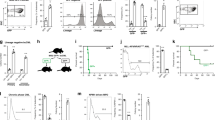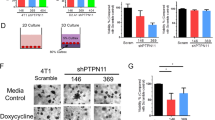Abstract
In leukemia patients, resistance to drug treatment develops while the malignant cells can interact with and derive support from their microenvironment, such as bone marrow stroma. To model this process, lymphoblastic leukemia cells from BCR/ABL transgenic mice were treated with the farnesyltransferase inhibitor (FTI) SCH66336 while in coculture with primary mouse embryonic fibroblasts. Coculture with fibroblasts allowed the outgrowth of a subpopulation of drug-resistant lymphoblasts that expressed N-cadherin, a cell–cell adhesion protein that normally is only expressed on specific cell types, including hematopoietic stem cells and fibroblasts. N-cadherin expression promoted increased adhesion of the lymphoblasts to the fibroblasts. Importantly, de novo expression of N-cadherin in parental nonexpressing lymphoblasts using lentiviral transduction increased the ability of the cells to survive FTI treatment. We conclude that FTI drug treatment of Bcr/Abl-positive lymphoblastic leukemia cells that are in contact with a defined microenvironment induces the selective survival of a more primitive subpopulation of leukemia cells that expresses N-cadherin. Experimental drug treatment of cancer cells in model systems that include a microenvironment may reveal novel molecules that contribute to drug resistance and may aid in the design of specific therapies to eradicate more primitive cells.
This is a preview of subscription content, access via your institution
Access options
Subscribe to this journal
Receive 12 print issues and online access
$259.00 per year
only $21.58 per issue
Buy this article
- Purchase on Springer Link
- Instant access to full article PDF
Prices may be subject to local taxes which are calculated during checkout





Similar content being viewed by others
References
Ren R . Mechanisms of BCR-ABL in the pathogenesis of chronic myelogenous leukemia. Nat Rev Cancer 2005; 5: 172–183.
Heisterkamp N, Groffen J . BCR/ABL Gene Structure and BCR Function. In: Carella AM, Daley GQ, Eaves CJ, Goldman JM and Hehlman, R (Eds.). Chronic Myeloid Leukemia: Biology and Treatment 2001, pp 3–17.
Peters DG, Hoover RR, Gerlach MJ, Koh EY, Zhang H, Choe K et al. Activity of the farnesyl protein transferase inhibitor SCH66336 against BCR/ABL-induced murine leukemia and primary cells from patients with chronic myeloid leukemia. Blood 2001; 97: 1404–1412.
Reichert A, Heisterkamp N, Daley GQ, Groffen J . Treatment of Bcr/Abl-positive ALL in P190 transgenic mice with the farnesyl transferase inhibitor SCH66336. Blood 2001; 97: 1399–1403.
Hoover RR, Mahon FX, Melo JV, Daley GQ . Overcoming STI571 resistance with the farnesyl transferase inhibitor SCH66336. Blood 2002; 100: 1068–1071.
Nakajima A, Tauchi T, Sumi M, Bishop WR, Ohyashiki K . Efficacy of SCH66336, a farnesyl transferase inhibitor, in conjunction with imatinib against BCR-ABL-positive cells. Mol Cancer Ther 2003; 2: 219–224.
Brodsky AL . Apoptotic synergism between STI571 and the farnesyl transferase inhibitor SCH66336 on an imatinib-sensitive cell line. Blood 2003; 101: 2070–2071.
Mishra S, Zhang B, Groffen J, Heisterkamp N . Treatment of advanced P190 Bcr/Abl positive leukemia with a farnesyltransferase inhibitor. Leukemia 2004; 18: 23–28.
Zhu K, Hamilton AD, Sebti SM . Farnesyltransferase inhibitors as anticancer agents: current status. Curr Opin Investig Drugs 2003; 12: 1428–1435.
Karp JE, Lancet JE . Farnesyltransferase inhibitors (FTIs) in myeloid malignancies. Ann Hematol 2004; 83: S87–S88.
Russo P, Loprevite M, Cesario A, Ardizzoni A . Farnesylated proteins as anticancer drug targets: from laboratory to the clinic. Curr Med Chem Anti-Canc Agents 2004; 4: 123–138.
Jorgensen HG, Allan EK, Graham SM, Godden JL, Richmond L, Elliott MA et al. Lonafarnib reduces the resistance of primitive quiescent CML cells to imatinib mesylate in vitro. Leukemia 2005; 19: 1184–1191.
Roskoski Jr R . Protein prenylation: a pivotal posttranslational process. Biochem Biophys Res Commun 2003; 303: 1–7.
Fiordalisi JJ, Johnson II RL, Weinbaum CA, Sakabe K, Chen Z, Casey PJ et al. High affinity for farnesyltransferase and alternative prenylation contribute individually to K-Ras4B resistance to farnesyltransferase inhibitors. J Biol Chem 2003; 278: 41718–41727.
Manabe A, Murti KG, Coustan-Smith E, Kumagai M, Behm FG, Raimondi SC et al. Adhesion-dependent survival of normal and leukemic human B lymphoblasts on bone marrow stromal cells. Blood 1994; 83: 758–766.
Garrido SM, Appelbaum FR, Willman CL, Banker DE . Acute myeloid leukemia cells are protected from spontaneous and drug-induced apoptosis by direct contact with a human bone marrow stromal cell line (HS-5). Exp Hematol 2001; 29: 448–457.
Fortney JE, Zhao W, Wenger SL, Gibson LF . Bone marrow stromal cells regulate caspase 3 activity in leukemic cells during chemotherapy. Leuk Res 2001; 25: 901–907.
Heisterkamp N, Jenster G, ten Hoeve J, Zovich D, Pattengale PK, Groffen J . Acute leukemia in BCR/ABL transgenic mice. Nature 1990; 344: 251–254.
Voncken JW, Griffiths S, Greaves MF, Pattengale PK, Heisterkamp N, Groffen J . Restricted oncogenicity of BCR/ABL P190 in transgenic mice. Cancer Res 1992; 52: 4534–4539.
Zhang B, Groffen J, Heisterkamp N . Resistance to farnesyltransferase inhibitors in Bcr/Abl-positive lymphoblastic leukemia by increased expression of a novel ABC transporter, ATP11A. Blood 2005; 106: 1355–1361.
Awada A, Eskens FA, Piccart M, Cutler DL, van der Gaast A, Bleiberg H et al. EORTC Early Clinical Studies Group. Phase I and pharmacological study of the oral farnesyltransferase inhibitor SCH66336 given once daily to patients with advanced solid tumours. Eur J Cancer 2002; 38: 2272–2278.
Mishra S, Reichert A, Cunnick J, Senadheera D, Hemmeryckx B, Heisterkamp N et al. Protein kinase CKIIα interacts with the Bcr moiety of Bcr/Abl and mediates proliferation of Bcr/Abl-expressing cells. Oncogene 2003; 22: 8255–8262.
Hardy RR, Carmack CE, Shinton SA, Kemp JD, Hayakawa K . Resolution and characterization of pro-B and pre-pro-B cell stages in normal mouse bone marrow. J Exp Med 1991; 173: 1213–1225.
Li YS, Hayakawa K, Hardy RR . The regulated expression of B lineage associated genes during B cell differentiation in bone marrow and fetal liver. J Exp Med 1993; 178: 951–960.
Elrick LJ, Jorgensen HG, Mountford JC, Holyoake TL . Punish the parent not the progeny. Blood 2005; 105: 1862–1866.
Holtz MS, Forman SJ, Bhatia R . Nonproliferating CML CD34+ progenitors are resistant to apoptosis induced by a wide range of proapoptotic stimuli. Leukemia 2005; 19: 1034–1041.
Copland M, Hamilton A, Elrick LJ, Baird JW, Allan EK, Jordanides N et al. Dasatinib (BMS-354825) targets an earlier progenitor population than imatinib in primary CML but does not eliminate the quiescent fraction. Blood 2006; 107: 4532–4539.
Puch S, Armeanu S, Kibler C, Johnson KR, Muller CA, Wheelock MJ et al. N-cadherin is developmentally regulated and functionally involved in early hematopoietic cell differentiation. J Cell Sci 2001; 114: 1567–1577.
Zhang J, Niu C, Ye L, Huang H, He X, Tong WG et al. Identification of the haematopoietic stem cell niche and control of the niche size. Nature 2003; 425: 836–841.
Wilson A, Trumpp A . Bone-marrow haematopoietic stem-cell niches. Nat Rev Immunol 2006; 6: 93–106.
Nelson WJ, Nusse R . Convergence of Wnt, β-catenin, and cadherin pathways. Science 2004; 303: 1483–1487.
Ziegler S, Rohrs S, Tickenbrock L, Moroy T, Klein-Hitpass L, Vetter IR et al. Novel target genes of the Wnt pathway and statistical insights into Wnt target promoter regulation. FEBS J 2005; 272: 1600–1615.
Lilien J, Balsamo J . The regulation of cadherin-mediated adhesion by tyrosine phosphorylation/dephosphorylation of β-catenin. Curr Opin Cell Biol 2005; 17: 459–465.
Bruzek LM, Poynter JN, Kaufmann SH, Adjei AA . Characterization of a human carcinoma cell line selected for resistance to the farnesyl transferase inhibitor 4-(2-(4-(8-chloro-3,10-dibromo-6, 1-dihydro-5H-benzo-(5,6)-cyclohepta(1,2-b)-pyridin-11(R)-yl)-1-piperidinyl)-2-oxo-ethyl)-1-piperidinecarboxamide (SCH66336). Mol Pharmacol 2005; 68: 477–486.
Mishra S, Zhang B, Cunnick J, Heisterkamp N, Groffen J . Resistance to Imatinib of Bcr/Abl P190 lymphoblastic leukemia cells. Cancer Res 2006; 66: 5387–5393.
Acknowledgements
We thank Didier Trono for PAX2 and envelope pMD2G plasmids and the CHLA Vector core for pCCL-PGK-EGFP, as well as Young Jin Cho and Jess Cunnick for helpful suggestions. We thank the FACS Core and the Image Core of the CHLARI for assistance with FACS analysis and imaging and Samuel Wu, Director of CHLA Clinical Cytogenetics, for the karyotype analysis. This study was supported by PHS NIH grant CA 50248 (NH), the TJ Martell Foundation (JG and NH) and the Kenneth T. and Eileen L. Norris Foundation (BZ, JG).
Author information
Authors and Affiliations
Corresponding author
Additional information
Supplementary Information accompanies the paper on the Leukemia Web site (http://www.nature.com/leu)
Supplementary information
Rights and permissions
About this article
Cite this article
Zhang, B., Groffen, J. & Heisterkamp, N. Increased resistance to a farnesyltransferase inhibitor by N-cadherin expression in Bcr/Abl-P190 lymphoblastic leukemia cells. Leukemia 21, 1189–1197 (2007). https://doi.org/10.1038/sj.leu.2404667
Received:
Revised:
Accepted:
Published:
Issue Date:
DOI: https://doi.org/10.1038/sj.leu.2404667
Keywords
This article is cited by
-
Programmed genomic instability regulates neural transdifferentiation of human brain microvascular pericytes
Genome Biology (2021)
-
N-cadherin in cancer metastasis, its emerging role in haematological malignancies and potential as a therapeutic target in cancer
BMC Cancer (2018)
-
Interplay of N-Cadherin and matrix metalloproteinase 9 enhances human nasopharyngeal carcinoma cell invasion
BMC Cancer (2016)
-
Galectin-3 in pre-B acute lymphoblastic leukemia
Leukemia (2013)
-
Expression of cassini, a murine gamma-satellite sequence conserved in evolution, is regulated in normal and malignant hematopoietic cells
BMC Genomics (2012)



